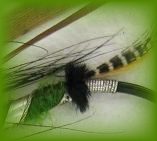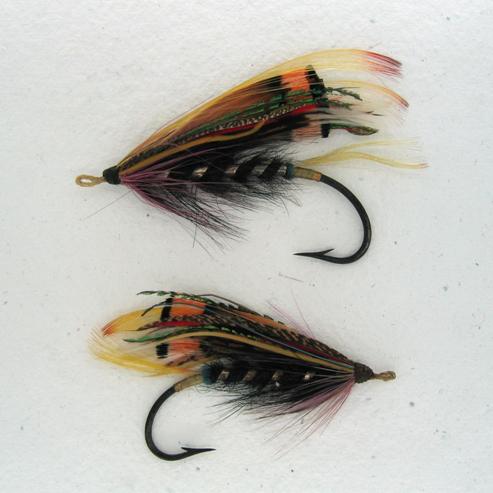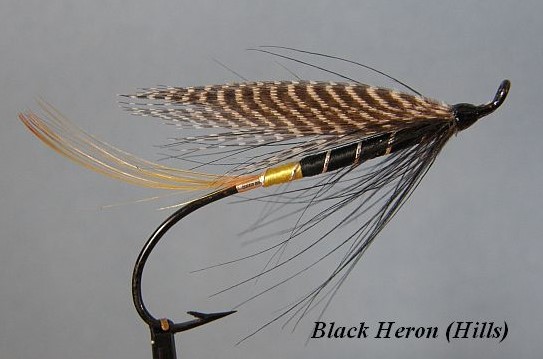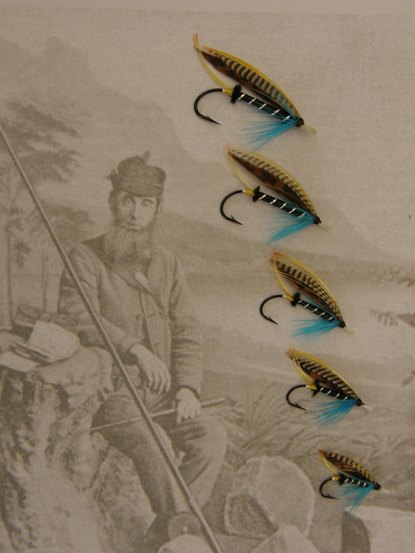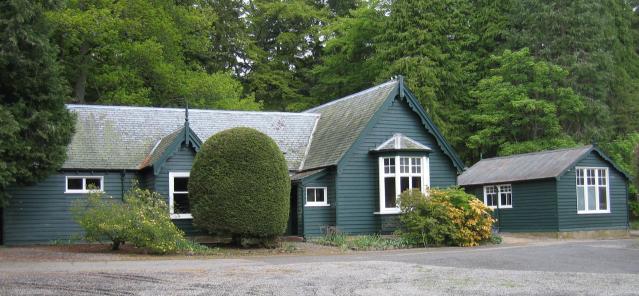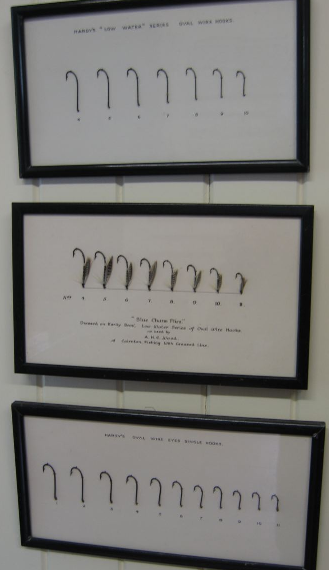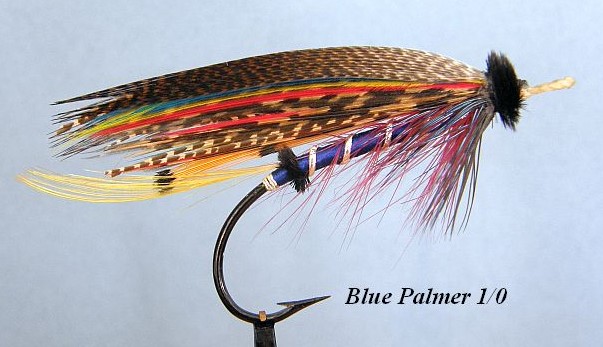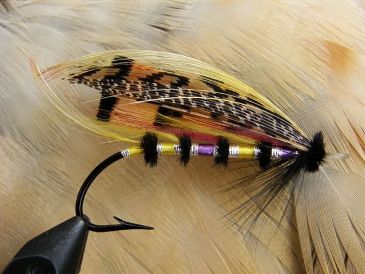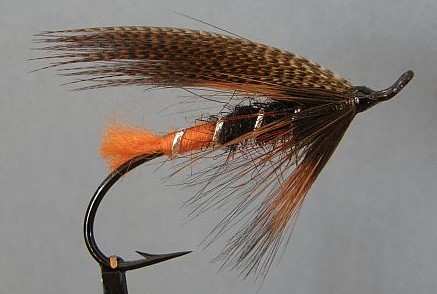 |
 |
|
On this page Black Dose, Black Heron, Black Tom, Blue Charm, Blue Palmer, Brora, Bruce, Bumbee, Butcher - Please page down to view Black Dose
A pair of vintage Black Dose Black Heron
Tied by Bob Frandsen Frederick Hill – Salmon Fishing – The Greased Line on Tag: Silver tinsel. Tail: Topping, or red ibis. Body: Two turns yellow silk, the rest black silk, oval or round silver tinsel. Hackle: Heron. Wing: Teal.
Hills mentions that this was a great favourite of Mr Anthony Crossley and that it’s best used in dark dirty water just before a rise in the river and also works in brilliant sunshine Black Tom Black Tom tied by Kjell-Ove Karlsen - not so easy to tie these small doubles! WM Tag: Silver twist and bright yellow floss. Tail: A small topping. Butt: Black herl. Body: Black silk floss. Ribbing: Narrow gold tinsel, four turns. Hackle: Claret dyed, three quarters down body, sparingly Throat: Pale blue cock hackle Wings: Two Indian crow feathers; two toppings; and a narrow strip of darkish, well marked teal on either side. Horns: Blue Macaw. Head: Black. Double Limericks, sizes Nos. 7 and 8. Almost certainly for grilse, is another fly very suitable for fishing with in clear water, and particularly in sharp, clean-bottomed reaches, when the sun is high. It is equally as deadly as the W.M. describes this fly as “one of our own patterns”
The Blue Charm Although a relatively simple pattern the Blue Charm has a reputation of being difficult to tie well. It was a favourite of AHE Wood of Cairnton (see Jock Scott - Greased Line for more details), so what better excuse to put up a picture of Mr. Wood fabulous fishing hut at Cairnton and some examples of the flies that are hanging on the wall of said hut! These pictures were taken by Malcolm Thorne:
The fishing "hut" built for AHE Wood at Cairnton on the Dee
Hardy hooks and Blue Charms hanging on the wall of the "hut".
Detail of the Blue Charm frame - tied by Hardy's for AHE Wood
A view of the inside of AHE Woods "hut"
Cairnton House - 9 bedrooms, 5 bathrooms, Billiard room, river at the bottom of the garden - not bad for a fishing lodge!
The house and hut from the other side of the river
Another view of the Cairnton beat
WM Tag: Silver thread. Tail: Small topping. Butt: Black herl. Body: Black silk floss. Ribbed: Narrow silver tinsel, 5 turns. Wings: Strips of mallard; very narrow strip distinctly marked teal over centre with mallard on either side, topping all over. Hackle: Bright blue hackle halfway down body. Head: Black Nos. 6 and 7 are very suitable sizes. The Blue Charm is as good a grilse fly as can be used from Banchory to Ballater; indeed, as its name implies, it is a perfect charmer. During the day nothing proves more effective in a moderately sized water, or a fairly heavy water not too much discoloured. When this fly takes well in the day time a small Jock Scott may be relied on in the evening. With no purely grilse fly we know of is the angler so little dependant on shade. W.M. describes this pattern as “one of a well known Deeside keeper”. William Murdoch Tag: Silver thread. Tail: A topping. Butt: Black herl. Body: Black floss. Ribbed: Silver flat worm. Hackle: Greenish blue - long and pretty full - at shoulder only. Wing: Double strips, distinctly marked dark brown mallard; along these up the centre on the outside a narrow slip of teal; topping over all. Head: Black wool. Sizes the most useful: Nos. 4, 5, 6, 7, Limerick Bend hooks (Bartleet and Sons’ scale). In response to repeated requests to give in our columns a detailed description of the clear weather files invented by him, and used with great success by himself and friends, Mr. Murdoch has sent on the above dressing which he says he has found to be the best of his inventions under the following conditions: An all-round killer - especially good on clear evenings about and after sunset in clear water, and in brown water under a strong sun.
Frederick Hill – Salmon Fishing – The Greased Line on Tail: Topping Body: Pale blue silk with silver tinsel, flat or embossed. Hackle: Blue green. Wing: Capercaillie cock a black body hackle, topping. Hills mentions that this is a “specially good modification for sunny days”.
The Blue Palmer
A very Irish (as it should be) looking one from Bob Frandsen Kelson – The Salmon Fly, 1885 Tag: Silver twist and dark blue silk. Tail: A topping. Butt: Black herl. Body: Dark blue silk. Ribs: Silver tinsel (oval). Hackle: Light red-claret from second turn. Throat: Jay. Wings: Tippet strands, dark turkey, bustard, golden pheasant tail; married strips of swan dyed yellow, red and blue; and two strips of mallard above. Head: Black herl. An excellent Irish pattern; and, when lightly dressed and used in summer, kills well on the Kelson attributes the pattern to Hardy Brothers. Hardy – Salmon Fishing, 1907 Tag: Silver tinsel and dark blue silk. Tail: A topping. Butt: Black herl. Body: Dark blue floss. Ribs: Silver tinsel. Hackle: Light red-claret. Throat: Jay. Wings: Tippet strands, dark turkey, bustard, golden pheasant tail; yellow, blue and red swan; Mallard. Head: Black.
The Brora Frederick Hill – Salmon Fishing – The Greased Line on Tag: Silver oval and light pink floss with 3 – 6 small blue chatterer feathers overlapping. Tail: Topping Body: Jointed in proportion as in Jock Scott. 1st silver oval with two toucan feathers, no butt. 2nd black floss ribbed with silver. Hackle: Black heron at shoulder only. Wing: Brown turkey with white and blue swan and pintail over, topping. Hills describes this fly as a large fly for the early part of the season in sizes 7/0 to No. 4
The Bruce or Mrs Hog
William Murdoch – 12th ???, 1887, Fishing Gazette Tag: Silver twist and canary floss. Tail: A topping. Butt: Black herl. Body: In four sections; each, except the last, butted with black herl. The second section is slightly longer than the first, the third slightly longer than the second, the fourth slightly longer than the third; and at each butt there is tied in on the back of the iron a wisp of mohair which extends forward to the tail topping. 1st section: four turns silver twist, mauve floss, four turns silver twist; wisp of yellow mohair; black herl. 2nd section: Five turns silver twist, canary floss, five turns silver twist; wisp of claret mohair; black herl. 3rd section: Six turns silver twist, mauve floss, six turns silver twist; wisp of yellow mohair; black herl. 4th section: seven turns of silver twist, canary floss, seven turns silver twist; wisp of claret mohair. This description applies to a 2/0 Hackle: A natural black - at shoulder only. Wings: Fibres of tippet, enveloped with two strips pheasant tail feather - one on each side; a little bustard; two toppings over. Head: Black herl. The best clear-day, low water fly put on the Helmsdale, the Bruce is also a pronounced success on other North-country rivers, including This pattern is quite different from the Bruce listed by Kelson and Hardy
The Bumbee
A Bumbee from Bob Frandsen Kelson – The Salmon Fly, 1885 Tag: Silver twist. Tail: A tuft of orange wool (short). Body: One-third orange wool, followed by black seal’s fur. Ribs: Silver tinsel (oval) Throat: A coch-a-bonddu hackle. Wings: Mallard. A good fly in summer on the Pryce-Tannatt - How to Dress Salmon Flies, 1914 Tag: Silver tinsel. Tail: A tuft of scarlet Berlin wool Body: Ribs: Oval silver tinsel. Throat: A cochybondhu hackle. Wings: Brown Mallard strips (set horizontally). Hook: ¾ to 1⅛ inches.
Hardy – Salmon Fishing, 1907 Tag: Silver tinsel. Tail: A tuft of orange wool. Body: One-third orange wool, followed by black seal’s fur. Ribs: Silver tinsel. Throat: A coch-a-bonddu hackle. Wings: Mallard. Head: Black “Jock Scott” – Greased Line Fishing for Salmon, 1936 Tail: Tuft of orange wool. Body: Two turns of orange wool, remaineder black. Ribs: Silver tinsel. Hackle: Cock-a-bondhu. Wing: Mallard.
From the Aberdeen Press & Journal newspaper in June 1937 in a piece by Major J.L. Dickie called "Summer brings Whipped Cream of Angling"
"Summer flies My favourite flies for summer fishing are Blue Charm, Logie,
Jeannie, Jockie, and Silver Blue, but if these fail, I have a card up my sleeve
in Bumbee dressed with yellow silk
instead of orange wool, Lord Saltoun, The Cabbage, and Colonel Downman. "
Butcher
What's the collective term for a group of vintage Butchers? Kelson – Land & Water Cards The story of the Butcher may be given in a few words. The pattern was designed by Mr. Jewhurst, of Had the illustration shown more teal and gallina, it would have been better and truer to pattern. This famous fly is described in the following way: Tag: Silver twist and yellow silk. Tail: A topping, teal and powdered blue macaw. Butt: Black herl. Body: In four equal divisions, beginning with light red-claret, and continuing with light blue, dark red-claret and dark blue seal’s fur. Ribs: Silver tinsel, preceded on large hooks by silver lace. Hackle: Natural black from light red-claret seal’s fur. Throat: Yellow hackle and gallina. Wings: A tippet and breast feather of the golden pheasant, back to back. Both being well veiled on either side with slight slips of teal, golden pheasant tail, gallina, bustard and peacock wing, with strands of parrot and swan dyed yellow, and with two strips of mallard at top. Horns: Blue macaw. Cheers: Chatterer. Head: Black herl. Wallbran Tag: Gold twist and dark orange floss. Tail: topping and wood duck. Butt: Black ostrich herl. Body: Claret, blue and orange pig’s wool Ribbed: Three turns of broad silver twist. Hackle: Light claret, dark claret at shoulder with small kingfisher at each side. Wings: Under, a tippet and golden pheasant’s rump feather, over them strips of brown mallard, bustard, peacock’s wing, wood duck, and slips of blue and yellow swan. Head: Black. Pryce-Tannatt - How to Dress Salmon Flies, 1914 Tag: Silver thread and lemon floss. Tail: A topping and blue chatterer. Butt: Black herl. Body: Fiery brown, pale blue, claret, and dark blue seal’s fur in equal sections (picked out). Ribs: Flat silver tinsel and twist. Hackle: A dark claret or black hackle. Throat: A lemon hackle followed by speckled gallina. Wings: A pair of tippets (back to back) covered by a pair of golden pheasant breast feathers, and these by a pair of broad strips of teal;”married” narrow strips of yellow swan and bustard, scarlet and blue swan, orange swan, and golden pheasant tail; strips of brown mallard over (rather broad). Cheeks: Blue chatterer; a topping over all (sometimes there is no topping). Horns: Blue and yellow macaw. Hook: 1¼ to 2 inches Hardy – Salmon Fishing, 1907 Tag: Silver tinsel and yellow floss. Tail: A topping, teal and blue macaw. Butt: Black herl. Body: In 4 equal parts of seal’s fur viz., red, blue, red and blue. Ribs: Silver tinsel. Hackle: Black hackle. Throat: A Yellow hackle and guinea fowl. Wings: Tippet and breast feather of golden pheasant veiled with teal; golden pheasant tail; guinea fowl; bustard; peacock wing; parrot; yellow swan; mallard. Cheeks: Chatterer. Horns: Blue macaw.
|
